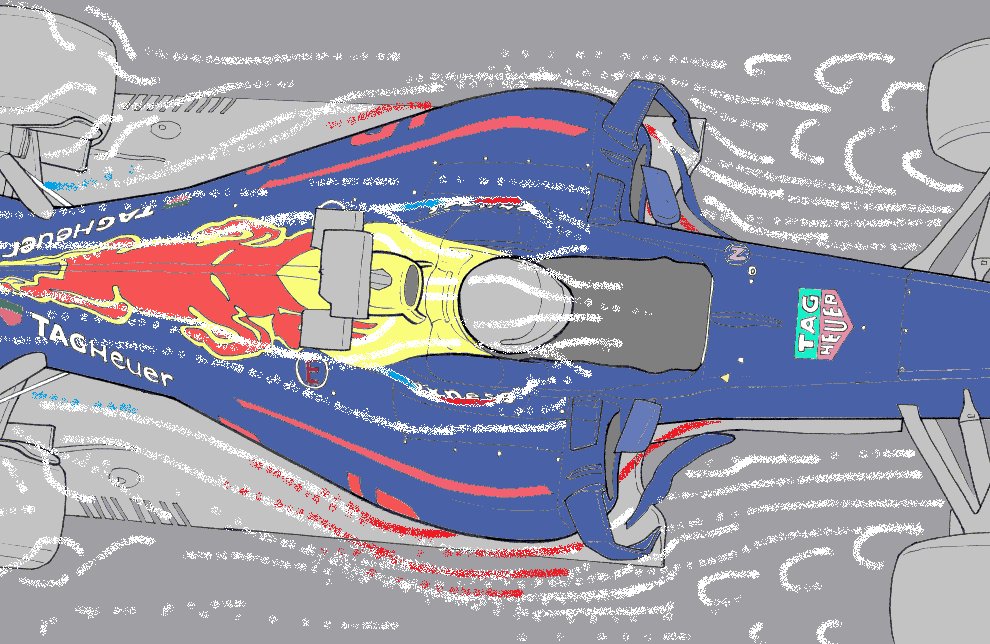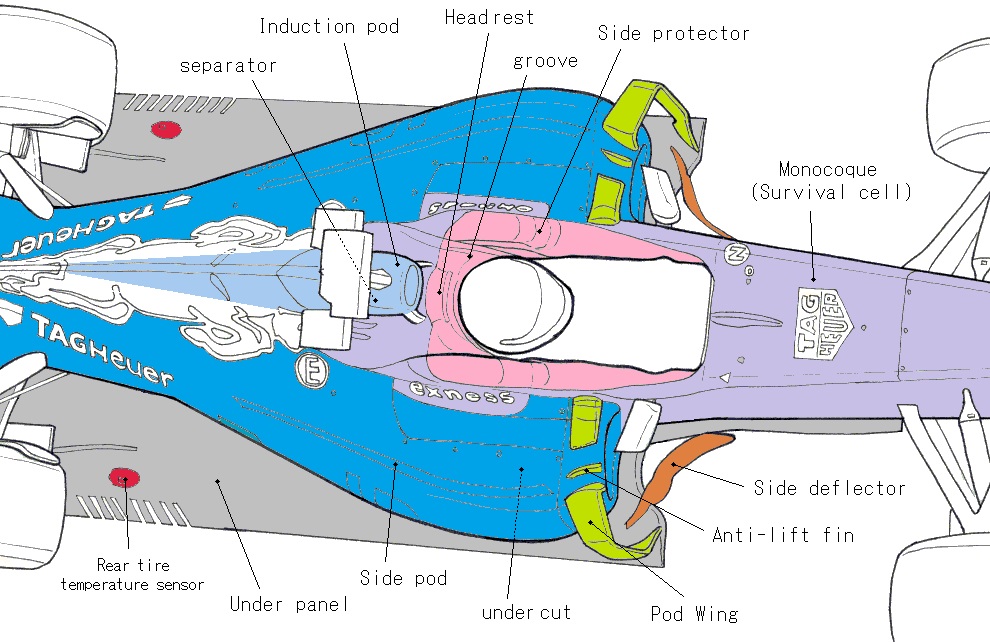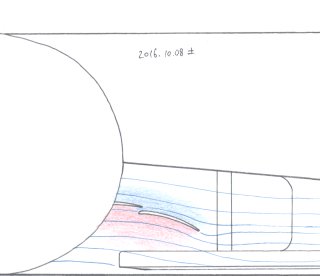[ Red Bull RB12 ] text & illustration by tw (Original text : February 23, 2016) [ Japanese language ]
(This page has been translated into English on May 18, 2016.)
On February 22, 2016, Red Bull for the 2016 machine "RB12" has been published.
The power unit will continue to use the Renault, but the name became Tag Heuer.
Please watch the photos of RB12 in the F1 Tsushin.
The biggest feature in their aerodynamic, but that the lower portion of the side pod side is narrow.
It is, more of the Toro Rosso is using from earlier than Red Bull.
Red Bull from 2014, made the decision to narrow the side pod bottom. And it has been from last year, to make it clear.
On the other hand the other teams in, are only undercut the front part of the side pod.
(With a value close to the maximum width of 1400mm in the regulation, the maximum width of the side.)
The purpose of narrowing the side pod bottom :
At the top and bottom of the side from the fact that the speed of the airflow is different, clearly distinguish as it not mixed.
The bottom is fast airflow. Flowing and undercut and sides of the tunnel and coke bottle.
At the bottom of the foot box, there is a wing to direct the air to the vehicle body underside.
This wing by itself to generate the lift, and downforce for the under panel.
Since the end plates is not, there is a possibility that utilize vortex generated by the wing tip.
Tie rod is laid on the upper side of the lower arm. It has been lower package than last year.
This is the aim to lower the center of gravity.
However, the steering shaft may become necessary to more length, the total mass of the body is supposed to have increased.
A result, the weight amount to be placed is reduced.
Thus, the best height of the tie rod is not determined that.
Because of lower tie rod, the front wheel of the brake duct has moved to the top.
Induction pod next to the big size camera is slightly upper.
However, the camera is on the left side only. Therefore, not the reason of the aerodynamics.
Side protector side is gently tinged with thickness.
This is a role to adjust the turbulence behind the low rear-view mirror.
Swan-neck of the rear wing stay.
As a whole, RB12's evolved. Not innovation.
If Tag Heuer(Renault) weaker than the Ferrari, might also when the Toro Rosso and the order is reversed.
Regulation of the current of the bodywork has been very regulated.
It is difficult to fill the difference of the power unit in the aerodynamics.
The driver in the same pair as last year, but Daniel Ricciardo and Daniil Kvyat.
(The contents of the February 23, 2016. From the Spanish GP, Kvyat and Max Verstappen has been replaced.)
It finished the Baku of the eighth round.
This season, the aerodynamic performance of Red Bull R12 has been proven to be very good.
Before the opening, I admit that it had underestimated the RB12 on this page.
At that point, even if there is a reason that there were only a handful of viewing possible photo.
In the main issue. When the RB12 compared with another car, the shape of the side protector is the characteristic.
(*For the name of each of the parts, please refer to here.)
Characteristically, from the top portion of the side protector, it is a shape to sink rapidly to the back.
Therefore, the air flow is joined from the left and right.
(The following is a conceptual diagram that I infer.)
Red of the image shows the high flow, Blue of the image shows the slow flow.

Between the headrest and side protector, there is a groove.。
The depth of the groove was found when I saw the survival cell after removing the side protector.
Airflow passes through the groove, to be supplied to the back of the side protector.
Then, the separator in the induction pod, divided into horizontal airflow, to assist in the flow of the above.
The point is, it is this cooperation play.
In this area, to not even too fast, to not even too late, might have achieved the economy flow rates.
[About the name of each part. List]

updated: October 19, 2016.
RB12 is equipped with a flap on the lower side of the foot box. (Sorry a simple sketch.)
In this sketch, red area indicates a high pressure. Blue area shows a low pressure.

The purpose of this flap is actively supplying the airflow to the vehicle body underside, but in order to improve the downforce generation amount at the underbody.
(There is a diffuser at the rear end of the under panel. Diffuser By pulling out the air flow of the underbody, underbody generates a downforce become a low pressure.)
Air, from the pressure high places, flowing pressure to a lower place.
Therefore, if increasing the pressure in front of the air flow under panel, the air flow sucked into the vehicle body lower surface.
On the Bernoulli's theorem, to the extent the amount of air flow through the body lower surface is large, the pressure drops in the flow rate is faster.
The purpose of the flap to promote it's this.
In the video of the Malaysian GP, it was able to confirm that this is the gap flap.
If the gap flap, to prevent flow separation at the flap upper surface, can be air foot boxes under the flap space clean.
Perhaps, the proportion of air resistance that this flap occupied in the body work would be less.
The breakdown of the air resistance, but the following synthesis.
1. the front of the high pressure of the structure.
2. After the side of the low pressure.
3. frictional resistance between the structures.
In the case of this flap, separator of the monocoque is present on the back side.
For this reason, air resistance due to the low pressure of the flap rear will be small.
[ Home page]